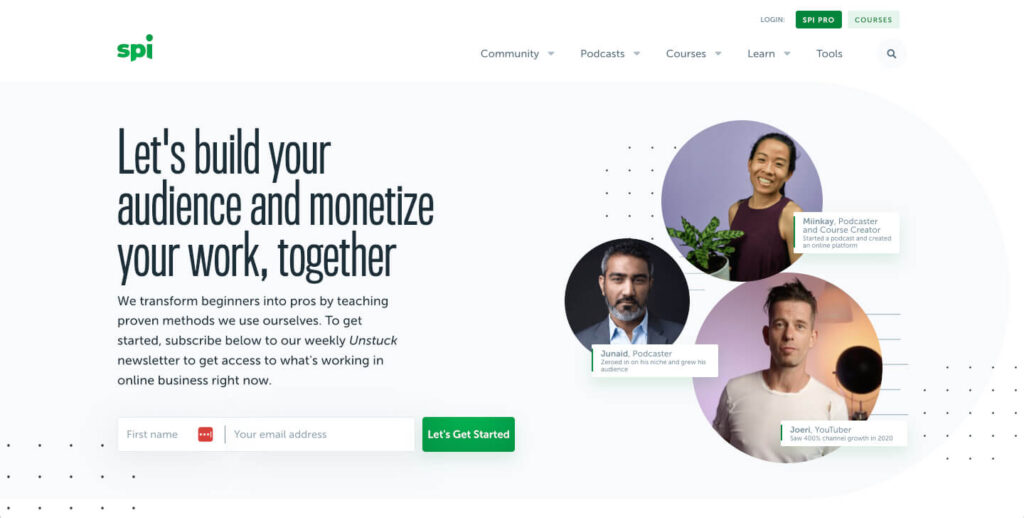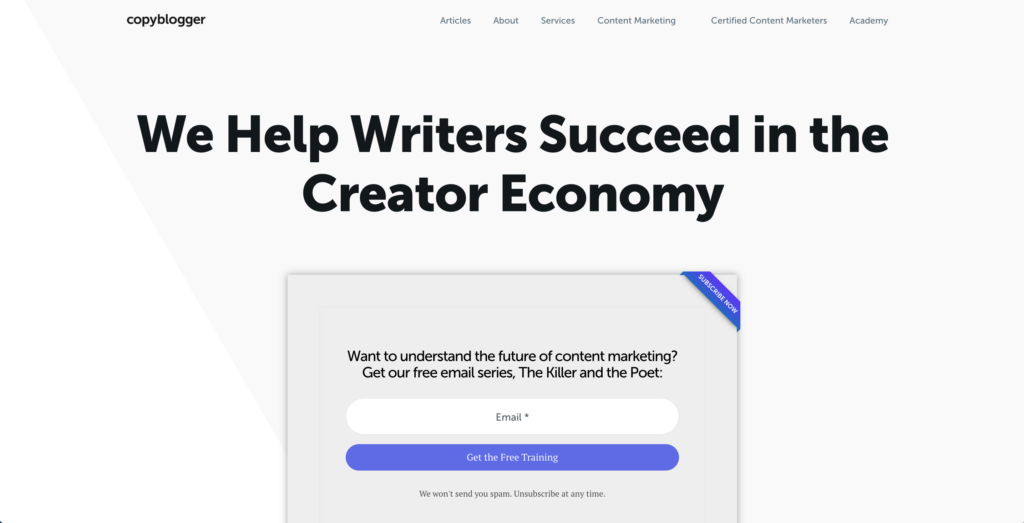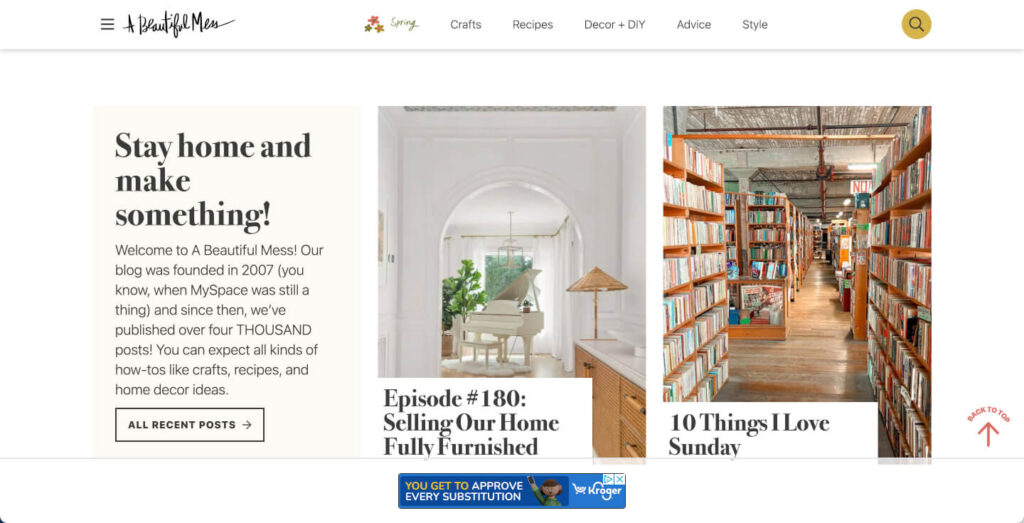The idea of monetizing a blog can be exciting as you dream about the passive income potential, but actually making money from your blog can be a whole different story. Blog monetization is not an easy feat and requires careful planning, strategy, and consistent effort.
In this post, I’m sharing what you should know before you monetize including popular methods for monetization and what kind of results you can expect.
(This article contains affiliate links, which means I may receive a small commission for purchases made through links in this post at no extra cost to you. I only recommend products I 100% believe in. Read the Privacy Policy for details.)
What You Should Know Before You Monetize Your Blog
Before you start monetizing your blog, there are a few important things you should know and consider.
1. Establish your blog niche.
It’s important to have a clear picture of your blog’s niche, expertise and audience. This will help you build a solid blog foundation and create quality content that actually resonates with your readers. This will also help guide you in the content creation process as you try to come up with blog topics to write about.
If you are constantly posting on a range of unrelated topics, (ie. think of gardening meets Etsy products meets coffee roasting), you are going to have a harder time building up your readership base because your strategy and content lacks a clear focus.
When it comes to your blog’s niche, try to think bigger picture and establish an umbrella theme under which 4-5 different categories/sub-topics would make sense. Let’s say you want to start a blog about entrepreneurship as your main theme. Your sub-topics (or content pillars) could be something like strategy, marketing, finances, and leadership.
Create content that addresses your readers issues and desire for information that fits well with those topics that you’ve established instead of just writing about whatever your little heart fancies at the moment.

2. Make sure you understand the legal + ethical implications.
There are several legal and ethical requirements that you should be aware of in terms of monetizing your blog. Here are some of the most important ones you don’t want to overlook:
- Disclose affiliate relationships: If you use affiliate links to promote products or services on your blog, you absolutely MUST disclose these relationships to your readers. This means clearly stating that you receive a commission if someone clicks on your link and makes a purchase. (Check out the sample affiliate disclosure below for a best practice implementation!)
- Label sponsored content: If you are paid to publish content on your blog, such as sponsored posts or product reviews, you must label this content as “sponsored” or “paid” to avoid misleading your readers.
- Follow advertising guidelines: If you use advertising on your blog, such as Google Adsense, you must follow advertising guidelines to ensure that the ads are not misleading, false, or deceptive.
- Protect user data: If you collect personal data from your readers, such as email addresses or credit card information, you must take steps to protect this data and comply with privacy laws such as GDPR or CCPA.
- Pay taxes on income: If you earn income from your blog monetization efforts, you must report this income to the appropriate tax authorities and pay any applicable taxes.
- Avoid plagiarism and copyright infringement: You must ensure that all content on your blog, including text, images, and videos, is original or properly licensed to avoid copyright infringement or plagiarism.
- Be honest and transparent: Finally, it’s important to be honest and transparent with your readers about your monetization efforts. Avoid using deceptive or misleading tactics to boost your income, such as placing ads too close to high-traffic buttons, and always prioritize the needs, interests and user experience of your readers over your own financial gain. Because being a good human is more important than any amount of money you could ever make from your blog.
Sample affiliate link disclosure for your blog posts
“Disclosure: Some of the links in this post are affiliate links. This means that, at no additional cost to you, we may earn a commission if you click through and make a purchase. We only recommend products and services that we have personally used or thoroughly researched. For more information on how we use affiliate links on our blog, please refer to our Terms of Service (link)”
This disclosure has 3 key components that make it a really solid statement.
- It clearly states that the post contains affiliate links and that you may earn a commission if the reader clicks through and makes a purchase.
- It also clarifies that you only recommend products and services that you have personally used or thoroughly researched, which helps to build trust with your readers.
- Lastly, it links to a page where your readers can find more info about your links and affiliate partnerships.
You should place your affiliate disclosure at the beginning of your blog post or prominently near the affiliate links to ensure that readers are fully informed before potentially clicking on any affiliate links you might have in your content.

Acknowledge that monetization isn’t going to happen overnight
In order to make money from your blog, you have to have at least some blog traffic. Whether that’s from organic search, social media marketing or other marketing tactics, you have to eyes on your content in order to monetize it.
There is no hard and fast rule for how much traffic you should have before monetizing your blog, but, generally speaking, many ad networks require a minimum amount of traffic to be eligible for their programs.
For example, Google AdSense requires a minimum of 1,000 page views per day, while some other ad networks may require 10,000 to 100,000 page views per month.
In my experience, I think blog monetization makes sense once you’ve reached about 400-500 page views on your website / blog per day. This will give you a good enough foundation of traffic and potential for clicks and conversions on your posts and and affiliate links. As your blog traffic grows, the more page views and visitors you’ll have, and the more your potential income grows too!
Once your blog traffic reaches 10K-50K pageviews and beyond, your earning potential will grow significantly. If you are already at this traffic level or higher, you should definitely consider blog monetization!
Best Industries for Blog Monetization
While many industries and niches can benefit from blog monetization, some are better suited than others. Generally, niches that have a high demand for information, products, and services tend to see the most success (and income) with blog monetization. Some of the best industries for blog monetization include:
- Health and wellness
- Personal Finance
- Technology
- Lifestyle and fashion
- Food and cooking
- Travel and tourism
But even if you don’t see your niche listed above, there is plenty of room for blog monetization success in other industries, and potentially yours too. Here are some examples of other niche brands that are monetizing their blogs in more ways than one:

Smart Passive Income
This blog by Pat Flynn focuses on teaching people how to build successful online businesses. Pat monetizes his content through affiliate marketing, selling his own courses and ebooks, and promoting his podcast and speaking engagements.

Copyblogger
This content marketing blog monetizes its content through affiliate marketing, selling its own courses and products, and offering premium content and membership programs for its readers.

A Beautiful Mess
This lifestyle blog has built a successful business around sponsored content, affiliate marketing, and selling its own products, such as books and online courses. They also offer a membership program and premium content for their readers.
Popular Methods to Monetize Your Blog
There are several methods to monetize your blog, and the best approach depends on your niche, audience, and business goals. Here are the top five most popular ways to monetize your blog IMO:
- Affiliate Marketing: Affiliate marketing involves promoting other businesses’ products or services on your blog in exchange for a commission on sales. Some of the most popular affiliate marketing programs are Amazon Associates, ShareASale, CJ Affiliate, or LikeToKnowIt (formerly Reward Style). Affiliate marketing works best for blogs that have a strong following and a niche audience that is interested in the promoted products.
- Ad Placements: You can earn money by displaying ads on your blog through Google Adsense or by directly selling ad space to businesses. This method works best for blogs that have high traffic and a broad audience since often, your earnings are tied directly to the number of clicks that your visitors make.
- Sponsored Posts: Sponsored posts involve partnering with other businesses to create content that promotes their products, services, or content. This method works best for blogs with a large solid readership base, and niche expertise because it’s based on the trust of your audience and that you are only featuring brands that you genuinely endorse. Many brands won’t provide sponsorships unless your website is already at a certain level of traffic/engagement.
- Selling Digital or Physical Products: You can sell your own digital or physical products, such as e-books, courses, merchandise, or physical goods using a shopping cart app like Thrivecart, Shopify Starter or WooCommerce. This method works best for blogs that have a loyal following and a niche audience that is interested in the products.
- Subscription Content: You can charge your readers for access to premium content, such as in-depth guides, exclusive interviews, or highly-personalized advice. This method works best for blogs with a strong reputation and niche expertise. If you are using WordPress, Restrict Content Pro, is an great, easy-to-use plugin to charge for this type of “gated” content. Or you may consider alternate platforms like Memberful, Patreon, or Teachable that also offer similar “pay-to-read” functionality.
You might choose to use one, a few or all of the methods described above, depending on how hard you want to lean into your monetization efforts. Decide which strategy makes the most sense for you to start with and then build onto it once you mastered it.
For example, I began promoting affiliate links in my blog posts after a few years of working to increase my blog subscribers and traffic. Now, I consistently promote my favorite affiliate products/services, in addition to my own products throughout my blog content and in my sidebar.

How to Start Monetizing Your Blog
Monetizing your blog should be a strategic part of your overall blog strategy, not an afterthought. Here are some tips to approaching monetization strategically:
- Research good brand partnerships: When considering brand partnerships and affiliations, it’s important to identify companies or products that really align with your blog’s niche and audience. Look for some of your favorite brands that share your values and that your readers would be interested in learning more about too.
- Create a spreadsheet to stay organized: Organize your blog content and potential partnerships/sponsorships/affiliates using a spreadsheet with columns for the blog post topic, potential partners or sponsor’s contact info, outreach status, and compensation details. This will help you keep track of potential partnerships AND help you track your monetization goals.
- Write an outreach email to send to potential sponsors: When reaching out to potential sponsors, be sure to personalize your emails and highlight the value that your blog can offer such as background info on your blog’s niche, audience, and engagement statistics, and explain why partnering with your blog would be beneficial to the sponsor.
- Create a media sheet: This is a great cheat sheet to highlight the benefits of your blog traffic and potential viewership for partnerships and advertisers. Think of a one-page document that includes key statistics and information about your blog, such as your audience demographics, social media reach, and website traffic.
- Generate ideas for products to develop and sell: Consider developing digital or physical products that align with your blog’s niche and that would be of interest to your readers. This could include e-books, online courses, merchandise, or other products that you know your readers would actually pay for.
- Adjusting your blog design: Make room for ad placements or featured products including adding a sidebar banner, creating a dedicated “Shop” or “Products” page, or including call-to-action buttons within your blog posts.
What Kind of Results Should You Expect from Monetization
The impact of your monetization efforts will vary greatly depending on your approach, niche, audience, and marketing strategy. Some bloggers earn a few hundred dollars per month, while others earn six or seven-figure incomes.
However, it’s important to set realistic expectations from the get-go and understand that monetizing your blog is NOT a get-rich-quick scheme. It takes time, effort, and dedication to build a successful blog that generates a steady stream of income.

How to set a realistic income goal for blog monetization
Setting realistic goals for blog monetization is crucial to avoid disappointment and burnout. Here are some tips on how to set achievable goals for your blog monetization efforts:
- Research your niche thoroughly: Before you start monetizing your blog, research your niche to understand the earning potential and competition. Look for successful bloggers in your niche and study their monetization strategies. If you’re lucky enough, you may also be able to preview income reports or commission statements that they share on their blog.
- Analyze your traffic and engagement: Use tools like Google Analytics to track your blog’s traffic, engagement, and audience demographics. This data will help you understand your audience and their preferences, which will help you tailor your monetization strategy.
- Set specific, measurable goals: Set specific, measurable goals for your blog’s income, traffic, and engagement. For example, you might want to start out with a goal of $100 per month from affiliate marketing. Once you have a starting point, you can adjust it as needed.
- Break down your goals into actionable steps: Break down your goals into smaller, actionable steps that you can take to achieve them.
- For example, in month 1 you might set a conservative goal, let’s say $100 per month (from affiliate marketing).
- To get that first $100 you might want to identify 1-3 affiliate programs that best align with your niche. Sign up for those programs and keep track of them in a spreadsheet. Organize your affiliate URLs for each affiliate and leave a spot to track your earnings month to month.
- Once you’ve signed up for the programs, you’ll want to start creating high-quality content where those affiliate mentions would make sense. Decide on how often you are willing to post – I’d recommend posting at least once a week if not 2 or 3 times a week.
- Add the affiliate links within your content and then continue to promote that content on social media, and optimize it for SEO to ensure you are getting the most traffic possible.
- Visit your affiliate reporting dashboard at the end of each month to add up your income and revise your next month’s goal as needed.
- For example, in month 1 you might set a conservative goal, let’s say $100 per month (from affiliate marketing).
- Be flexible and willing to adapt: Especially with the rise of AI tools, and changing search algorithms, blogging is a constantly evolving field. Your monetization strategy may need to change over time. Be flexible and willing to adapt to changes in your niche, audience, and marketing landscape.

How Long Does It Take to Make Money from Blogging
Monetizing a blog can take time, effort, and patience. While some bloggers may see success within a few months, others may take a couple of years to earn a significant income. The timeline for monetization depends on several factors, such as your niche, audience size, content quality, and overall marketing strategy.
If you don’t earn any income in your first few months of monetization, don’t be discouraged. You may just have to adjust your approach in marketing your content, or continue building your traffic up to around the 10K mark. Continue to trial and error different strategies to find what works best for you.
Monetizing a blog can be a rewarding way to earn passive income while sharing your passion and expertise with the world. By following these tips, you can increase your chances of success and achieve your blogging income goals. Remember, building a blog that builds passive revenue takes time, effort, and patience, so stay focused and keep creating quality content that resonates with your readers.
Need help with your blogging strategy? Reach out to K Design Co.













